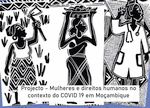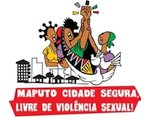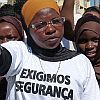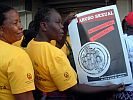Sexual Violence and Child Rape,
a Discussion of Concepts
Conceição Osório
This is the first of a series of articles on the results of a small research project on child rape in Maputo[1]. We shall begin by discussing some of the conceptual issues that we feel can contribute to a reflection on the child rape dimension of sexual violence, namely, ambiguity in the sexual abuse concept and its classification. We shall try to show that, given its ambivalence, the notion of sexual abuse used by many authors is not suitable for an analysis of sexual violence against children.
The literature on child rape in Mozambique – covering the relationship between age, penalties, intra- and inter-institutional articulation – is either scattered in partial texts that assess application of the law and institutional mechanisms or the texts are too comprehensive for a discussion of the various dimensions of rape. Studies that discuss the concepts used are rare, and those that analyse the interference of cultural representations in institutional practices even more so.
In addition to Mozambican literature on the subject a number of studies in the region and in the world will also be analysed.
Studies in Mozambique
In her research on violence and the sexual abuse of children, Brigitte Bagnol tries to reflect on the relationship between violence and sexual abuse, presenting how the law differentiates between the two concepts (Bagnol, 2004). However, the content of the two concepts and how they differ is unclear.
Referring to rape as a form of abuse, the author states “sexual abuse exists in various forms, in this case in exchange for payment”. (Bagnol, 2004:12). We feel, however, as do several of the authors quoted in this paper, that sexual abuse covers a variety of different manifestations of violence against children, leading to an interpretation (by differentiating between abuse and rape) that dilutes the violent nature of abuse itself and, even more, that conceals the structure of social relations where power lies at the core. If, for example, we take into account social perceptions of premature marriage, it is obvious that the argument of the victim’s “consent”, (as expressed by the study in question) involves a form of abuse that may not imply rape. Nevertheless, in the gender violence context what occurs in a forced union between a child and an adult is a form of sexual violence.
Bagnol goes on to describe the variables that determine and affect condemnation of sexual abuse, identifying payment of a fine or marriage as a way of cancelling out the crime. Another study by Collet (2010) on sexual violence in Tete province, quotes a respondent expressing a similar view:
“In some areas, sexual abuse is considered an extension of tradition. For them, using of the term “sexual abuse” is almost an insult because for them sexual abuse is not a problem; a problem only arises when the girl does not marry. If a father has a daughter aged 12, 13, 14, 15 years of age and a man appears and wants to marry her, her father says “that’s fine”, because the honour and dignity of his traditions have been preserved” (Collet, 2010).
School and home are considered the spaces where sexual abuse is most frequent, whether in the form of harassment (in-school), for reasons related to new myths (family enrichment), or debt or the above-mentioned premature “marriage”.
Dropping out of school, in the case of girls in particular, can be a sign of sexual violence practices there, such as harassment and rape, that can also reflect more subtle forms of violence within the family manifested in the division of labour in the home, and ritualization (silent or otherwise) to conform to subordinate roles. Transferring these roles to school, by constructing models of domination previously developed within the family, generates opportunities for the production of violence in schools. A survey by MEC (Ministry of Education and Culture, 2008) of Gender Units in five provinces showed that 70% of members this sector and of the pupils interviewed said that many teachers in schools sexually harass and abuse pupils and many of these cases result in pregnancy. The report also mentions the existence of “a promise of marriage”, as a cause of dropout and girls being handed over to men immediately after their first menstruation.
Nevertheless, as a painful silence conceals cases of rape it has not yet been possible to prepare statistics on the subject or take punitive measures. Once again it is interesting to note that these cases go unpunished and the complicity of families. The Ministry of Education report also describes situations where the victim does not denounce rape for fear of being stigmatised by her family and community. The stigma only disappears when the aggressor marries or lives in a de facto union with the girl. In other words, rape and the resulting trauma are aggravated by the victim’s social/cultural obligation to agree to share a home with her rapist, concealing and decriminalise the crime. These cases are the result of cultural representations where there is no violence or rape as long as there is compensation. As already mentioned, a power relationship that permits the violation of human rights pervades the construction of gender identities. When there is no gender approach to the rape of girls, the logic of patriarchal domination makes this rape appear natural (as the text makes clear, for example, by describing the rapist as a “normal” person).
As in other literature, this report shows that “concepts of harassment and sexual abuse are unclear, except when they result in pregnancy”. (Ministry of Education and Culture, 2008:9). As stated in the MEC report, this situation continues to allow the police to accept relatives’ withdrawal of their complaints, on the grounds that “sexual abuse” does not exist in the current Penal Code in Mozambique. This could be resolved (at least in the sense of getting to know reality) by developing a concept of sexual violence that includes all its dimensions.
Another study, containing a detailed analysis of the situation of children’s rights in Mozambique (Rede Criança, 2009) calls attention to the possibility that children’s rights are being violated because Mozambican law establishes that criminal responsibility applies to children aged between 16 and 18 years. This contradicts the Convention on the Rights of the Child that establishes 18 as the age limit. In a specific reference to child rape, the report identifies it as one of the most visible dimensions of violation of children’s rights. However, as in the other studies, there is no conceptualisation of sexual abuse, leading to the construction of a wide range of situations that are of no help in analysing reality.
A study on premature “marriages” reveals the family and social structure that promotes them (Nhantumbo et al., 2009). Referring to the factors behind premature marriage the text mentions “girls’ interest in becoming economically and socially independent” and also “girls’ apparent interest in marriage could be related to the fact that the points of reference for an individual’s integration into adult life are physiological and cultural events…” (Nhantumbo et al., 2009:13).
However, we feel that the conclusion that a girl’s interest in accessing resources could be an explanation for premature marriage should be seen in the context of gender social relations where the construction of new dependencies is natural. This means that forced unions of children with adults only appear to give girls access to more resources because, in reality, resources such as land, having children and taking care of them, are part of the construct of a gender identity marked by subordination.
The passage to adulthood through premature marriage is a way of maintaining the patriarchal order i.e. of limiting the rights of girls and women to a structure and a hierarchy where the main component is power. This means that the apparent emancipatory nature of the passage to adulthood contained in this kind of union serves essentially to maintain and reproduce male domination. We feel that it is wrong to define premature marriage as “a girl’s economic and social emancipation strategy”. Firstly, because this union does not mean consent even when it appears to (due to the construction of female and male social identities within the family context) and secondly, because in practice it means that inter- or intra-family solidarity mechanisms are being maintained by violating rights. By ignoring the fact that community and family “peace” is being maintained by the submission of individuals to a hierarchical structure according to their sex and age, and by not taking into account the changes that are taking place in this structure, we limit the observation of reality to a fatalist stability of female subordination.
The same issue arises and requires reflection, when sexual violence is seen as a violation of human rights and attempts are made to curtail enjoyment of these rights so that they fit the cultural model. Making rights something relative, depending on a culture or the search for commitment, almost always ends up maintaining a structure of domination; the source of its legitimacy is a tradition that seeks to reproduce itself by renewing and/or recovering hierarchies and values that restrict rights. There are, however, studies (Osório and Silva, 2008, 2009) revealing signs that the gender structures that some want to be culturally justified by a fixed model, are constantly changing with indications of breaches and defiance. When many children in parts of Manica run away from home in order to avoid being handed over to the men to whom they have been promised, or when leaders and families in Nampula and other places in the centre and north criticise the fact that “now girls and boys get married in the street”, they are showing unequivocally changes in the gender order that researchers and policymakers must study in detail and take into account when defining strategies. These practices can provide the basis for a reflection and a broad debate that reveal new realities and encourage counter-cultural policies.
In order to avoid ambiguity in the analysis of premature “marriage” as a component of a given social order, it would be interesting to include it in a gender structure where initiation rites are the culminating moment. Along the same lines, a discussion of traumatising socialising practices such as puxa puxa[2] (while not considered genital mutilation) must consider them a form of symbolic mutilation that reduces a girl’s body to sexual “service” could help to break our comfortable complicity. This approach would make it possible not only to deconstruct the role of rites in formatting gender identities, but also to define strategies that target access to and enjoyment of human rights.
Considering “the child as a social category and infancy as the space in which this category acts” (Nhantumbo et al., 2009:20) the above-mentioned study includes an interesting discussion on incompatibility between the socio-cultural concept and the legal definition of the child. Using premature “marriage” as an example, the paper states that from the cultural standpoint, what defines a child is its dependence on and obedience to relatives, with no possibility of negotiation. This means that the child is not a rights holder. Through family and community socialisation mechanisms a child (a girl in particular) is prepared to pass from being a subject without rights to a subject with rights limited by the gender structure. A girl’s conformity with (and even adherence to) the violence and rape expressed in premature “marriage” conceals a cultural reality based on discrimination and the exclusion of rights.
As part of its advocacy work on children’s rights, in order to analyse the media’s role in publicising manifestations of violence against children, MISA Mozambique studied coverage of this problem by the country’s written press (MISA, 2008). In the case of sexual violence against children, the study found that rape is rarely denounced; the perpetrators are not punished, especially when it occurs within the family and at school. Nevertheless, the study did reveal that while articles describing sexual abuse of children did receive press coverage, there was little emphasis on abuse in the family context. The reports studied merely presented the facts, with no information on the legal implications, nor did they advocate punishment for the perpetrators. The absence of a critical approach by the media and their failure to mention mechanisms that protect children’s rights help feed social silence and diminish the violation of children’s rights. The authors’ recommendations are very important for the protection of children’s rights, in particular “the need to include a gender approach when covering subjects related to protecting children” and publicising violence against children from a human rights perspective, contributing to social and legal sanctions (MISA, 2008:35).
Another study based on literature on violence against children produced in Mozambique analyses the current situation of children’s human rights from a multi-disciplinary perspective (FDC, 2008). As we have found in other research activities, sexual abuse is regarded in a broader sense, covering different manifestations where the target is the sexual body. The study felt that intra-family sexual abuse was the most common form followed by sexual abuse in schools where girls were the most affected group. Once again we come up against considerable conceptual ambiguity. On the one hand, the broad definition of sexual abuse implies that all and any form of offence with a sexual purpose falls within this definition and on the other hand, when sexual abuse is analysed it is always linked to violence or even rape. These difficulties do not only arise in the theoretical field, but also in the definition of policies and mechanisms for fighting sexual violence, as shown by the statement “the sexual abuse of minors also occurs within the community in the form of rape, understood as a form of violence where an individual forces another to have sexual intercourse against that person’s will”. (FDC, 2008:19).
As we shall have the opportunity to analyse in subsequent articles, some of the people we interviewed had a common sense attitude towards sexual abuse i.e. too broad and confused with consequences for the arbitrary application of the law. The failure to identify sexual abuse as sexual violence leads to the conclusion that sexual abuse of children can occur without violence. In other words, under certain circumstances abuse takes place with the victim’s consent. We feel that implicit to this idea is the notion that seduction and the victim’s acquiescence in violence misses the main point, which is that the underlying feature of contexts that produce abuse is always a power relationship that can lead to silence and the “peaceful” and “passive” prolongation of violence. This issue is all the more important when one recognises that most sexual abuse victims are girls, who are socialised to serve the “other”, i.e. whose identity has been groomed for subordination.
Some of the difficulties we have found in the use of concepts applied to specific situations of sexual violence, have been expressed clearly in research carried out in Tete province (Collet, 2010). Firstly, it raises the problem that there is no corresponding term for sexual violence in local languages and this could affect knowledge of reality if there is no prior understanding between researchers and public policy makers. In addition, the study is unclear about what constitutes sexual abuse. Identifying it as “a type of rape” (Collet, 2010:3) can lead to the idea that there are various forms of rape, with different degrees of severity and sanction. Ambiguity in the terms “sexual violence” and “sexual abuse” and their arbitrary use is resolved by the definition of sexual violence produced by the World Health Organisation (WHO):
“Sexual violence is any sexual act, attempt to obtain a sexual act, unwanted sexual comments or advances, or acts to traffic, or otherwise directed, against a person’s sexuality using coercion, by any person regardless of their relationship to the victim, in any setting, including but not limited to home and work”[3].
This is different to the above-mentioned author’s definitions based on other research in the country, for example, when citing Matavele’s study that “defines the sexual abuse of minors as the involvement of a child in any sexual act or activity with an adult or older children, that occurs prior to the legal age of consent” (Collet, 2010).
Ambivalence in differentiating between descriptions of sexual abuse and sexual violence is also revealed in the perceptions of people interviewed by the author, as in the focus group with pupils in Moatize Secondary School. The definition they gave was: “there is sexual violence and sexual abuse; sexual violence is any act involving sexual intercourse between adults, whereas sexual abuse is the act between an adult and a minor (….)” And “Sexual violence is having sexual intercourse against the will of the other party and not only this, also having sexual intercourse with an underage person” (Collet, 2010: 22).
Through the words of cadres working in the health sector, the legal sector and civil society organisations the study also shows pronounced differences between their description of sexual violence and rape, namely, whether or not there was copulation.
Sexual abuse in international literature: East Africa, two paradigm cases
Some more recent studies in Sub-Saharan Africa have tried to analyse the relationship between child rape and the legal framework and institutional mechanisms for defending human rights. They raise doubts about strategies for preventing and fighting sexual violence.
The authors of a study in Kenya (ACORD, 2010) found that although the Kenyan Constitution agrees with the definition of violence in the Beijing Declaration and its Platform for Action, the justice system remains insensitive as shown by the feeble police and court investigations of rape cases. In addition, the government has done little in terms of legal and administrative instruments to protect rape victims, even though the country has ratified international instruments that protect them and condemn rape. The fact that these instruments have not been translated into national laws is used as an argument for not applying them. And this is in a context where the conflict situation in Kenya has led to alarming levels of rape, a situation further aggravated by the weakness of legal institutions that protect human rights.
The country’s justice administration system comprises the informal, traditional justice system and the legal, formal system. Disputes in rural communities continue to be regulated by informal instances, whether due to the absence of local, formal structures or the influence of a justice model that citizens consider to be faster and less costly. For example, the legitimacy of the informal justice system has allowed rape cases to be resolved through payment of a fine. Although victims and their families can appeal to the formal courts, in practice the actions of justice officials reflect traditional conflict resolution practices. So although there are laws that guide the treatment of rape cases, police officers do not apply them, using the argument of the severity of the penalties. Many rape cases are withdrawn due to the absence of proof while others are resolved in police stations without any legal basis, and the rapist always ends up being released in exchange for money[4].
As regards the courts, when the victim is a minor the penalty for rape is a prison sentence of 15 years. Deliberate contamination with HIV during rape is an aggravating factor. Nevertheless, many cases do not run their course as the victim and witnesses disappear while the case is ongoing or request clemency for the rapist and the application of measures in accordance with usage and custom. As a result of these constraints, cases drag on for a long time. Moreover, victims must pay witnesses to go to court or the case will not proceed.
As happens in Mozambique, as we shall show below, although Kenya’s health services have a protocol system that must be applied it is still very weak and depends on the heightened awareness of health personnel and the victim’s knowledge of the required procedures. This makes articulation with formal justice instances difficult, so most rape cases go unpunished.
The ACORD study (2010), which also covered the situation in Uganda, shows that the absence of consensus on the definition of sexual violence enables each researcher or institutional agent and civil society activists to use the term in an arbitrary manner, and this has implications for care and sanctions. The study applies the term “sexual violence” to any kind of sexual behaviour that resembles sexual abuse, sexual aggression, sexual harassment and voyeurism. The term “gender violence” is widely used as a synonym for violence against women.
Like Kenya, Uganda has a plural legal system. It does, however, have a legal apparatus for handling cases of sexual violence and rape. The issue here is the system’s weakness and the fact that most rural people resort to informal instances that are governed by the patriarchal model when hearing cases.
The administration of justice takes place at various levels that include the police, the prosecution, the medical examiner and the courts. The problem starts when the victim decides to report the crime. The police are the point of entry and responsible for investigating and detaining the rapist but victims often have to travel long distances to reach the nearest police station. If it happens to be located close to the victim’s residence or the places where the crime was committed, the police do not have sufficient training to deal with rape cases. They often do not have either the knowledge or the specific skills to assist (often traumatised) victims, or knowledge of the legal framework. When police stations are far from where the case occurred, as they are poorly equipped and without resources they ask the victims to provide money and transport so they can go to the crime scene or detain the perpetrator.
The evidence ends up in a police report without any kind of specific medical assistance for sexual violence victims, who also have to bear the additional cost of paying for the medical report. This document requires a signature and data from a doctor. However, doctors refuse to sign in order to avoid being called to give evidence in court, and only do so in exchange for money. Consequently, the outcome that reaches the Prosecutor’s Office is frequently inadequate and many cases are filed for lack of proof. If the case proceeds it comes up against other obstacles, such as delays, corruption and high legal costs for the victim. After 360 days without a trial, suspects must be released.
Some examples of international research: concepts and contexts
Ambiguity in the definition and classification of the sexual abuse of minors has led an important group of researchers to raise epistemological issues. Amazarray and Koller (1998) describe the differences between various authors in some clear cases of the sexual abuse of minors. Authors such as Cristoffeli et al. (1992, cited by Amazarray e Koller, 1998)[5] include in the abuse concept a wide range of manifestations ranging from negligence to physical violence. Those such as Watson (1994, quoted by Amazarray and Koller, 1998)[6] describe “sexual abuse as any activity or interaction where the intention is to stimulate and/or control the child’s sexuality”.
Another scholar (Knutson, 1995, quoted by Amazarray and Koller, 1998)[7] refers to the problems created by the lack of clear definitions and the scope of sexual abuse, affirming that “it must not be limited to the activity or the act in itself, but must also involve interactions that could even be verbal (…) and that the difference in age must not be the main requirement for the diagnosis, as it is the power relationship established between the perpetrator and the victim that characterises this interaction” (Amazarray, 1998: 3). The text also refers to the equivalence between sexual abuse and incest, and between statutory rape and rape outside the family context.
These multiple categories and dimensions for describing sexual violence/abuse hamper stringent data recording, including clarifying the contexts that produce violence and defining the profiles of victims and perpetrators. This situation, which was also found in our research as we will show in future articles in this bulletin, inhibits integrated recognition of the problem and thus results in its devaluation and invisibility.
Referring to sexual violence, Amazarray and Koller suggest that “silence pardons the perpetrator and strengthens his power over his victim. The perpetrator does not see the victim as a person but as an object completely devoid of feelings and rights” (Amazarray, 1998: 1). This also happens in Mozambique, where education that inculcates obedience and violent rituals that are not challenged promote the victims’ silence, especially when rape is committed within the family, the same family that should protect them and on whom they depend. Along these lines, referring to the different realities in the world, the same authors, citing Kaplan e Sadok[8] (1990), state that the victim’s shame, guilt and forbearance combined with “the reluctance of some professionals to recognise and report sexual abuse, court insistence on rigid rules of evidence and the family’s fear that it will collapse” discourage complaints (Amazarray, 1998: 5).
The consequences of sexual violence for children are horrific. They require trained multi-disciplinary teams to prevent the psychological damage being intensified by justice and health personnel. As we found in our research in Maputo, by not denouncing rape they are in fact contributing not only to perpetuating it but also, in particular, to making the victim feel guilty and legitimising aggression. Moreover, the absence of external signs of consummated rape and trauma does not mean that the child has not suffered immense damage. We shall return to this question in subsequent articles, by analysing interviews that reveal clearly the offhand and slipshod way in which some people observe and treat child rape in Maputo city.
A study on the sexual abuse of children in the form of incest shows that over 95% of rapists are men and the author identifies a number of negative effects, in particular: “the anguish of post traumatic stress, the constant relational imbalance and the high risk of generational incest” (Nunan, 1998: 20). For other authors, abuse (understood as sexual violence against children) in the intra-family context in particular, is sometimes very difficult to prove, extends over a long period and is a family secret such that in most cases it becomes banal (Araújo, 2002). Breaking the pact of family silence and denunciation would force the deconstruction of gender roles and challenge the dominator, the one with the power to impose rules, to define good and bad. This is the main reason for concealing sexual violence against minors within the family. The paper states that research by Saffioti in São Paulo, Brazil in 1997 found that “71.5% of perpetrators were biological fathers and 11.1% stepfathers. So fathers and stepfathers were responsible for 82.6% of all sexual abuse cases (Saffioti, 1997: 183)[9].
A study of families where there has been sexual violence against children (Penso et al., 2002) analyses sexual abuse as a form of violence characterised by a sexual relationship that is determined by unequal power:
“Understanding its particular significance for each person involved (….). As a child/adolescent the victim is in a subservient position and unable to fully comprehend the nature of this relationship in the context of all the others she has with her parents and/or caregivers. In turn, the perpetrator of the abuse takes advantage of the dominated’s trust and dependence in order to take over her sexuality” (2009:143).
Drawing on Saffioti[10], Araújo (2002) states that male domination is a structuring feature in a social order that submits functions and roles to a model that is not only androcentric but also adultcentric, combining gender submission with generational submission. This is what he means when he says that “a woman’s submissive relationship to violent male power is to some extent linked to a daughter’s submission to the generic violent power of her father, of her own father over her, and of the daughter’s parent over his own child” (2002:150). This means that by remaining silent about her partner’s aggression against her daughter, the wife is fulfilling a mandate that is inscribed in the patriarchal model.
In the case of Mozambique when some researchers, leaders or public opinion makers appeal for peaceful interaction between culture, tradition and human rights, citing the specific characteristics of a local identity in order to decriminalise, conceal or reconcile cultural interests with legal measures (ignoring the fact that the violation of rights is part of a global androcratic/androcentric model), they are in fact encouraging the children of these parents remaining without any rights.
One cannot overlook the fact that, especially in the family context, child rape must be seen within the framework of the same cultural tradition that naturalises domination by the father, the uncle, the stepfather or the brother, in a situation where dependence, guilt and affection towards the adult interacts with a normative shaper of gender violence.
In the literature on different social realities, the issue of the ambiguous definition of sexual abuse has meant that sexual violence is understated and thus also its medical and legal treatment. In this respect, Amendola states as follows:
“Sexual violence against children, also known as sexual abuse, sexual aggression, sexual victimisation, ill treatment, sexual servitude, sexual crime and so many other terms used indiscriminately in the literature as synonyms, reflects not just a terminology issue but mainly an epistemological issue. The way the complex and diverse manifestations of sexual violence are addressed conforms to the opinions and ideologies of individuals and/or shared by the culture of which that individual is part” (Amendola, 2009: 200).
This also means that the portrayal of sexual violence must take into account the surrounding contexts and values in order to prevent issues of a moralising kind from intervening in this categorisation. For example, this is a case identified in our research where some informants considered that little boys aged 5/7 who interact bodily with little girls of the same age, are sexual aggressors. Including a prejudiced view of something that involves children learning about the bodies of each other, does not just introduce a violent dimension into what is merely a child’s “game”. It could also produce trauma, leading to the notion that sexual differences and sexuality are something sinful and secret. This does not contribute to a child’s passage to adulthood, a recognition of rights.
Research in Guine-Bissau on the sexual exploitation and abuse of minors criticises a list of definitions of sexual abuse, pointing out that for most authors, including the United Nations Children’s Fund (UNICEF), the criterion for sexual abuse is sexual contact or a sexual act between a child and an adult in a context where force and power are used. Presented in this way, the definition of abuse appears to be a synonym for rape, ignoring other forms of violence, namely those based on gender inequality (Có et al., 2006).
The study states that the main sexual violence and rape practices in West Africa are female genital mutilation (see the emphasis on this subject elsewhere in the bulletin), forced marriage, early pregnancy and high miscarriage risk. (It is estimated that in Sub-Saharan Africa adolescents account for 40% of risky miscarriages). On the subject of premature marriage the study states “It is foreseen that in the next 10 years over 100 million girls will be married before they complete 18 years of age (…..) and that currently roughly 44% of married women in West Africa are under the age of 15” (Có et al., 2006: 20) in a clear breach of the law. Moreover, and referring to the violence caused by armed conflicts in sub-Saharan Africa the authors state:
“Kidnapping for war and rape purposes is associated with a rise in HIV/AIDS and sexually transmitted infections. For example, between 28,000 and 30,000 children under 18 years of age (where half are between 10 and 14 years of age) are abandoned to prostitution in South Africa. It is estimated that during the genocide in Rwanda, half a million girls and women were kidnapped, and 67% were infected with HIV/AIDS. Eighty percent of the world’s HIV positive children are orphans (children of parents who died from HIV/AIDS) living in Sub-Saharan Africa. In 2003, it was estimated that 15 million of the 143 million orphans living in Asia, Africa and the Caribbean had lost their parents to AIDS and 12 million of these children lived in Sub-Saharan Africa” (Có et al., 2006: 20).
As in other countries, in Guine-Bissau there is silence about intra-family rape, and the Justice administration system is unable to get the law obeyed. Indeed, concealing the aggression reflects community pressure on the victims, ignoring their suffering and thus helping to encourage continued rape by the same or other perpetrators against new victims. In addition to those within the family, they also include those engaged in informal trade and living in the street. In this context, where children are not considered to have rights, forced marriages between children and adults become culturally natural and socially accepted. Nevertheless, as found also in our country, there are now signs of resistance by girls who refuse this disgraceful union, denounce it and alert civil society organisations or the police (Osório e Silva, 2008).
Conclusions
The rape dimension of sexual violence against minors has been studied by a wide array of researchers, especially those in the psychology and anthropology fields, but few have had a multi-disciplinary approach.
Given the research topic, the rape of children under 12 years of age, in the literature studied we have analysed three issues:
- The first is conceptual ambiguity, in particular between sexual abuse, sexual violence and rape. They are considered synonyms or categories and dimensions according to the arbitrary decision of researchers (for example, rape can be considered a dimension of the abuse category or its synonym) and the international agencies working with children’s rights. It is thus very difficult to identify rigorously the specific characteristics of each manifestation of sexual violence, define the contacts that produce them and the profiles of perpetrators and victims. As the data are scattered, the different approaches to concepts and their application when analysing real situations, the information provided must be addressed in relative terms.
- A second issue is that many studies do not look at rape in a gender relations context. Strength and power are frequently mentioned as structuring features in sexual violence but it is rarely considered as part of a social order based on gender hierarchies. The result is not just the transmission of a reductionist view of the problem, but concealment that often suggests complicity with cultural models that survive by negating the rights of female human beings. The fragility or vulnerability of children and adolescents to sexual violence, especially within the family, is related to and involves physical force. It is even more related to a construct where male domination is considered natural… We feel that this is a necessary and vital approach when analysing the violence that permeates, runs through and is made explicit in the social relations between the rapist and his victim.
- Finally, the third issue is linked to the construction of female and male identities. The body is the central nucleus where throughout the life cycle, values, behaviours and skills are inscribed. Identification mechanisms configure women and men according to the dominant social and cultural order. For this reason intra-family rape must be seen from a construction of sexuality perspective. As we have stated many times, learning about sexuality occurs through silences, through small and large prohibitions, formatting expectations in the light of the “other”. These paths prepare the child as a “useful” body and prescribe a norm that requires silence about sexual violence. So if we take into account the fact that “genuine” learning about the body’s “reserve” begins in the family context at the same time as teaching about the legitimacy of male power, it is understandable how the absence of denunciation and a pact of silence between family members and the community, constrain the crime’s visibility and the punishment. Moreover, ambiguity and/or valuing traditions (dynamic and constantly changing) continue to prevent premature “marriage” from being considered, once and for all, sexual violence/rape, that must be the object of policies and strategies to put an end to it.
Read the second part of this article
Bibliography
ACORD (2010), “Protection and Reparation under Congolese Law for Survivors of Sexual and Gender-Based Violence: Situational Analysis and Prospects for Reform“. Kampala: ACORD DRC
Amazarray, M.; Koller, S. (1998), “Alguns Aspectos Observados no Desenvolvimento de Crianças Vítimas de Abuso Sexual“. In: Psicologia Reflexão e Crítica, vol. 11, nº 3.
Amendola, M. (2009), “Analisando e (des)construindo conceitos: pensando as falsas denúncias de abuso sexual“. In: Estudos e Pesquisas em Psicologia, Ano 9, nº 1. pp 199-218
Araújo, M. F. (2002), “Violência e Abuso Sexual na Família“. In: Psicologia em Estudo, v. 7, nº 2. pp.3-11
Bagnol, B. (2004), Avaliação da Área Temática. Violência e abuso sexual de crianças. Maputo: Save The Children Norway. [Read more about Save the Children Norway’s work in the thematic area of violence against and sexual abuse of children by clicking here]
Có J. et al. (2006), Abuso e a Exploração Sexual de Menores na Guiné-Bissau. Guiné Bissau: INEP, UNICEF.
Collet, A. (2010), Pesquisa de Crenças e Atitudes em Relação à Violência Sexual Contra a Mulher e a Rapariga na Província de Tete. Maputo.
FDC (2008), Violência Contra Menores em Moçambique. Maputo
Ministério da Educação e Cultura, Direcção de Programas Especiais (2008), Relatório da auscultação através das Unidades de Género, Conselhos de Escolas e Jovens raparigas sobre que mecanismos a adoptar para a prevenção, combate, denúncia e encaminhamento de casos de assédio e todo o tipo de abuso, incluindo o abuso sexual na escola. Maputo.
MISA (2008), Violência, exploração e abuso sexual de crianças. Análise da cobertura jornalística e recomendações para os media, Maputo.
Nhantumbo, S. et al. (2010), Casamentos prematuros em Moçambique, contextos, tendências e realidades. Maputo.
Nunan, A. (1998), Abuso sexual de crianças. Rio de Janeiro: Pontifícia Universidade Católica do Rio de Janeiro.
Osório, C.; Silva, T. (2008), Buscando sentidos, Género e sexualidade entre jovens estudantes do ensino secundário, Moçambique. Maputo: WLSA.
Osório, C.; Silva, T. (2009), Género e governação local, estudo de caso na província de Manica, distritos de Tambara e Machaze. Maputo: WLSA.
Penso, M. et al. (2009), Abuso sexual intrafamiliar na perspectiva das relações conjugais e familiares.
Rede Criança (2009), Relatório da Sociedade Civil Sobre a Implementação da Convenção dos Direitos da Criança, Maputo.
[1] Led by Conceição Osório with Edson Mussa as research assistant.
[2] Puxa-puxa, as it is called locally, refers to the lengthening of the vaginal labia (elongated labia minora), a ritual that usually takes place between 8 and 15 years of age, and is often repeated after childbirth.
[3] WHO, 2002, World Report on Violence and Health (Chapter 6).
[4] The same thing happens in Mozambique, in the Offices for Assistance to Women and Child Victims of Violence located in police stations where victims have been ridiculed and intimidated.
[5] Christoffel, K. et al. (1992), Standard definition for childhood injury research. Washington, DC: NICHD
[6] Watson, K. (1994), Substitute care providers: Helping abused and neglected children. Washington, DC: National Center on Child Abuse and Neglected
[7] Knutson J.F. (1995). Psychological characteristics of maltreated children: Putative risk factors and consequences. In: Annual Review of Psychology, 46. pp. 401-431
[8] Kaplan, H I.; Sadock, B.J. (1990), Compêndio de Psiquiatria. Porto Alegre: Artes Médicas. (2nd edition)
[9] Cited by Araújo, 2002: Saffioti, H. (1997), No Fio da Navalha: Violência Contra Crianças e Adolescentes no Brasil Atual. In: Madeira F. (org), Quem Mandou Nascer Mulher?, São Paulo: Editora Rosa dos Tempos. pp. 134-211
[10] Saffioti, H. (2001), Contribuições Feministas para o estudo da violência de gênero. In: Cadernos Pagu (16). pp. 115-136







 Information in English
Information in English



















